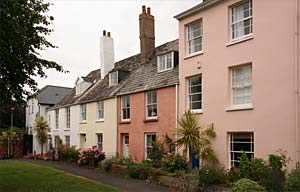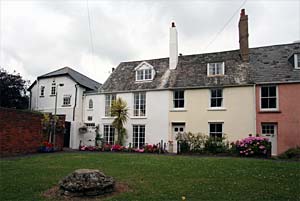
Little Silver
also known as Silver Terrace
Page updated 21st May 2017
 Little derives from Litel, meaning outside, while
Silver is the Latin Silva for wood - hence, 'wood outside the
walls'. The earliest of the cottages in Little Silver, No 1
dates from the 17th century and has a four
foot thick cob wall. No 5 is probably 18th century and the rest
Victorian.
Little derives from Litel, meaning outside, while
Silver is the Latin Silva for wood - hence, 'wood outside the
walls'. The earliest of the cottages in Little Silver, No 1
dates from the 17th century and has a four
foot thick cob wall. No 5 is probably 18th century and the rest
Victorian.
Little Silver is located on the southern boundary of St David's Church graveyard - a deed of Bishop Henry Marshall of 1194, mentions, among others, St David's Church, which gives some indication that dwellings alongside the church may have been present from a very early date. An abstract of deeds for No 1 Little Silver exists, with a lease and release from November 1709 which includes several cottages and dwelling houses – the document seems to indicate that the buildings are well established, so there must have been dwellings on the site from at least the 17th Century.
The document is between Edward Baker, fuller and John Rice, also a fuller, both of Exeter. No 1 is a rather fine house with higher ceilings than an artisans cottage would have, and traces of some fine plaster moldings. Fullers were men of some wealth at this time, and the quiet solitude of St David's Down would have been a choice location away from the bustle of the city for a family house, and yet, within walking distance for the woollen market and fulling mills along the Exe. One James Rice still had an interest in the properties in 1772, the date of the last agreement on the abstract.
The 19th Century
A property occupied by Mrs Sercombe, was put up for sale in 1803. In 1831, what were described as cottages were for rent, three of which were occupied by Messrs. West, Kemp and Cooke – they were squalid, dirty and overcrowded, taking the overflow from the West Quarter. After the 1832 cholera outbreak, the Exeter Improvement Commission in Exeter, initiated a city wide improvement of markets, streets, sewers and water supply. Speculative building followed in the wake and in 1839, a substantial advert in the Western Times ran:
LITTLE SILVER, ST. DAVID'S HILL. Eligible Investment, in Houses classing from £10. to £20. yearly Rent. TO be SOLD by private contract, several Brick-built DWELLING HOUSES, lately erected with Gardens, situated in the pleasant and healthy Row, called Little Silver, Near St, David's Church, and open to the fields.
* The Property has always been well tenanted, and will be found worth the attention of Persons desirous either of comfortable residences, or of a good investment of money. Further information may be obtained of Mr. JOHN HILL, Builder, Little Silver, or Gandy-street; Mr. RALPH SANDERS, Palace Gate; or of M. JAMES COMMIN, Cathedral Yard, Exeter.
The builder, John Hill took up residence in No 11 – In June 1847, Hill and his brother were declared bankrupt and in August he appears to have been forced to sell Nos.5, 8, 11, 12 15 and 16, as well as two properties in Bystock Terrace at auction.
Russell Terrace
Alongside the southern edge of Little Silver lies Russell Terrace. The first two of these dwellings date from 1833 when an advert in the Flying Post announced two brick built dwelling-houses in an unfinished state. This was the start of a building boom alluded to above.
Smoked out
During the 19th Century, some would start a business in their home. On J Hallett at No. 4 Little Silver informed the public in 1845 that he "that he has erected SMOKING and DRYING ROOMS on an entirely New Principle ; where Housekeepers and the Trade may depend on having their HAMS, BACON, &c, SMOKED AND DRIED IN SUPERIOR MANNER, by imparting to it that delicious flavour so much esteemed in Hampshire Bacon, &c." He invited customers to send their meat with "Parchment or Leather, to prevent mistakes" and he would return the order post free. One wonders if the neighbours had problems from the smell and smoke.
In 1889, no 2 Little Silver came up for auction and sold for £201.
The passage of carts along the path to Little Silver was of concern to some locals who sent a memorial to the Improvement Commission in 1833. As a result, a post was placed at the entrance, to prevent carts from entering. In 1842, the Commission agreed to construct 700ft of main sewer from Pound Lane to the Longbrook for the new Little Silver development.
The Improvement Commission received another memorial from the inhabitants of Little Silver in 1864, requesting a public lamp, while the footpath was adopted by the Council in 1881.
Mr Allen, an inhabitant, erected a wire fence to keep out his neighbours cat, which "frequently deported itself over his flower beds." The neighbour, Mrs Channing pulled the fence down. She was summonsed for the offence and fined 5s in 1871.
The inhabitants of the houses in the 19th-Century appear to have been blue collar workers, with railway employees, print workers and cab-drivers among those living in the houses. The grassed area in the square formerly had a central square of cottages which escaped the blitz, but were demolished in 1963 to leave an open green space. No 1 Little Silver was purchased by Karl Hawkins for £500, and who worked to regenerate the area. He acquired a coat of arms from St Mary Major Church that was demolished in 1972, and which can now be found on the front door of No. 1. A plinth from the same church can be found on the green in the front; on the base is a partial inscription to Sir Richard Vivian, Mayor in 1732.
The Hoskins' Family
Exeter's well remembered historian Professor W G Hoskins was born in 1908, above the family bakery at 26/28 St David's Hill, just around the corner from Little Silver. By 1911 the family had moved to No 8, Little Silver. The house had seven rooms where Hoskins, and two of his brothers lived. The family later moved back to the address in St David's Hill.
World War One Dead - Little Silver
Private, Reginald Stanley Bradford, Somerset Light Infantry. 14 May 1918. Age 26. Little Silver Private, Frederick George King, 7th Dragoon Guards (Princess Royal's). 14 July 1916. Age 29. Little Silver, St. David's
Sources: Flying Post, Western Times, Exeter and Plymouth Gazette and notes taken from a talk by Maeve Creber, and Angela Marks for the family information about Professor Hoskins.

 The plinth from St Mary Major Church at Little Silver.
The plinth from St Mary Major Church at Little Silver.
│ Top of Page │